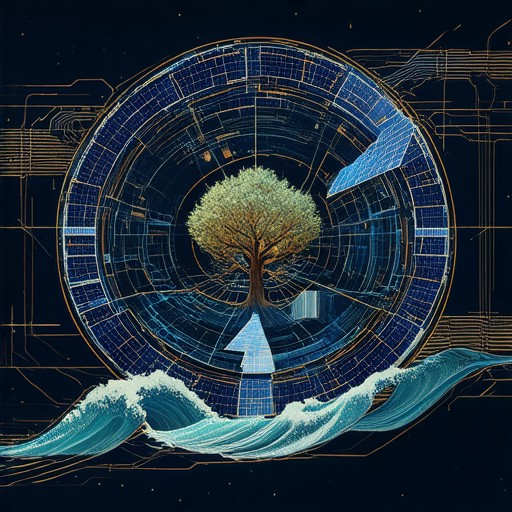Sustainable resource technology represents a transformative approach to addressing global challenges through innovative solutions that prioritize environmental stewardship and long-term viability. As industries increasingly seek alternatives to traditional resource extraction methods, sustainable resource technology emerges as a cornerstone of modern development. By integrating cutting-edge advancements with ethical practices, this field aims to harness renewable resources and minimize ecological harm, paving the way for a greener future. From renewable energy systems to circular economy models, sustainable resource technology encompasses a wide array of strategies designed to ensure sustainable growth while preserving natural ecosystems. This article delves into the fundamental concepts, real-world applications, and future prospects of sustainable resource technology, offering insights into how it can drive progress toward a more sustainable world.
Key Takeaways
– Sustainable IT Reduces Costs and Enhances Efficiency: By optimizing server performance and adopting energy-efficient practices, organizations can lower operational expenses and reduce their carbon footprint.
– Resource Conservation Prevents Waste: Implementing recycling programs and extending product lifecycles through repair and refurbishment helps minimize e-waste and promotes a circular economy.
– Green Software Development Lowers Computational Overheads: Agile programming and minimalist design practices reduce energy consumption and carbon emissions associated with software development.
– User Behavior Optimization Saves Resources: Encouraging energy-efficient device usage and device management tools can extend device lifespans and reduce unnecessary upgrades.
– Renewable Energy Leads the Way: Solar and wind energy are among the most sustainable options due to their scalability, minimal environmental impact, and widespread adoption.
– Sustainable Technology Protects Ecosystems: By minimizing emissions and promoting resource efficiency, sustainable tech helps preserve biodiversity and ensures a healthier planet for future generations.
– Long-Term Viability Ensures Durability: Sustainable technologies are designed to last, avoiding obsolescence and resource depletion, thus supporting economic growth and resilience.

Sustainable Technology Example
Sustainable technology encompasses innovations that minimize environmental impact while delivering benefits. Here are key examples:
- Renewable Energy Systems: Technologies like solar panels and wind turbines convert energy sustainably, reducing reliance on fossil fuels.
- Green Buildings: Structures designed with energy efficiency in mind, incorporating solar panels and geothermal heating, along with cities featuring green spaces and permeable surfaces to manage stormwater.
- Electric Vehicles (EVs): Cars and public transportation options like electric buses reduce emissions significantly compared to traditional vehicles.
- Waste Management Innovations: Composting, recycling programs, and waste-to-energy plants help reduce landfill use and convert waste into resources.
- Water Conservation Techniques: Rainwater harvesting systems and efficient irrigation methods, such as drip systems, minimize water usage and prevent runoff.
- Sustainable Agriculture Practices: Methods like permaculture farming enhance soil health, reduce chemical use, and promote biodiversity for long-term food production.
- Smart Grids: Integrated energy systems that optimize renewable sources with distribution networks, reducing energy waste and improving reliability.
- Battery Storage Solutions: Advanced battery technology supports consistent renewable energy supply, addressing intermittency challenges.
- Urban Planning with Sustainability: Green roofs, vertical gardens, and sustainable infrastructure contribute to eco-friendly cityscapes.
What Does Sustainable Technology Mean?
Sustainable technology refers to innovations and practices that aim to benefit both the environment and society while minimizing harm to ecosystems and natural resources. It focuses on creating technologies and systems that are environmentally friendly, socially beneficial, and economically viable in the long term.
Key Components of Sustainable Technology
- Renewable Energy Sources
Sustainable technology often involves harnessing renewable energy such as solar, wind, hydro, and geothermal power. These technologies replace traditional energy sources like coal and oil, reducing greenhouse gas emissions and promoting cleaner energy production. - Energy Efficiency
Sustainable technology prioritizes energy efficiency through innovations like smart grids, energy storage systems, and building design that minimizes energy consumption. These technologies help reduce waste and maximize the use of available resources. - Sustainable Agriculture and Food Production
Technologies like precision agriculture, vertical farming, and crop rotation help reduce agricultural runoff and soil degradation. These practices support sustainable food production while preserving biodiversity and natural habitats. - Water Conservation and Treatment
Sustainable technology includes advanced water purification methods, desalination plants, and efficient irrigation systems. These innovations help address water scarcity and improve access to clean water in arid regions. - Smart Cities and Urban Planning
Sustainable technology enables the creation of smart cities that are more efficient and livable. IoT-enabled infrastructure, renewable energy integration, and sustainable transportation options like electric vehicles and public transit apps contribute to a greener urban environment. - Sustainable Packaging and Consumption
Innovations in packaging materials and circular economy principles promote reduced waste and resource efficiency. Technologies like compostable packaging and refillable containers help minimize environmental impact. - Carbon Capture and Storage (CCS)
Sustainable technology includes carbon capture methods that remove CO2 from the atmosphere and store it underground. These technologies play a critical role in mitigating the effects of climate change.
Benefits of Sustainable Technology
- Reduces environmental degradation
- Promotes resource efficiency
- Lowers greenhouse gas emissions
- Enhances community well-being
- Supports long-term economic stability
By integrating sustainable technology into daily life, we can create a more sustainable future while ensuring the preservation of natural resources for future generations.

Sustainable Resource Uses
- Solar Energy: One example of sustainable resource use is the installation of solar panels. These panels convert sunlight into electricity, reducing reliance on fossil fuels and lowering carbon emissions. Many households and businesses around the world have adopted solar energy to power their operations sustainably.
- Composting: Another sustainable practice involves composting organic waste. By turning kitchen scraps and yard waste into nutrient-rich soil, individuals and communities can reduce landfill use and promote eco-friendly gardening. Composting is a simple yet effective way to reuse resources responsibly.
- Electric Vehicles: Sustainable transportation includes the use of electric vehicles (EVs). These cars and buses run on electricity, contributing less to air pollution and reducing greenhouse gas emissions compared to traditional fuel-powered vehicles. Governments and companies are increasingly investing in EV infrastructure to support widespread adoption.

Sustainable Information Technology
Sustainable information technology refers to the integration of environmentally friendly practices, policies, and technologies within the field of information technology (IT) to minimize its ecological impact while maximizing efficiency. The goal is to align IT operations with global sustainability goals, such as reducing carbon emissions, conserving resources, and promoting circular economy principles.
Key Components of Sustainable IT
- Energy Efficiency :
Sustainable IT focuses on reducing energy consumption in IT operations. This includes optimizing server performance, implementing server virtualization, and leveraging cloud computing to minimize energy waste. Energy-efficient data centers often employ cooling systems that reuse heat for other purposes, further reducing environmental impact. - Resource Conservation :
Sustainable IT emphasizes the conservation of resources, including water and materials. This involves using recycled materials in hardware manufacturing and encouraging e-waste recycling programs to prevent toxic substances from entering landfills. Additionally, sustainable IT practices advocate for the extension of product lifecycles through repair, refurbishment, and resale. - Environmental Impact Reduction :
IT contributes significantly to greenhouse gas emissions due to energy consumption and data center operations. Sustainable IT initiatives aim to mitigate these impacts by adopting renewable energy sources for data centers, reducing waste, and promoting sustainable software development practices. - Green Software Development :
Sustainable IT extends to software development, where practices such as agile programming and minimalistic design are prioritized to reduce computational overhead and carbon footprints. Open-source software and containerization technologies also play roles in fostering sustainability. - User Behavior and Device Optimization :
End-users can contribute to sustainable IT by selecting energy-efficient devices and optimizing their usage patterns. Employing device management tools to extend device lifespans and reduce unnecessary upgrades are also sustainable practices.
Governance and Policy
Organizations adopting sustainable IT strategies often establish governance frameworks to monitor and report on their environmental performance. This may involve obtaining certifications such as ISO 14001, which recognize organizations for their commitment to environmental stewardship.
Future Trends
The adoption of sustainable IT is expected to grow as organizations increasingly recognize the importance of environmental responsibility. Emerging technologies, such as AI-driven energy monitoring systems and blockchain for supply chain transparency, promise to enhance sustainability efforts in the IT sector.
By integrating these principles, organizations can position themselves as leaders in sustainable IT, contributing to a healthier planet while meeting the demands of a rapidly evolving digital landscape.
Learn more about Pyrolysium’s sustainable IT initiatives .
Sustainable Technology Overview
The most sustainable technology involves practices and innovations that minimize environmental impact while maximizing efficiency. Among the leading contenders are renewable energy sources such as solar and wind power.
- Solar Energy: Utilizes sunlight to generate electricity through photovoltaic cells or solar thermal systems. It is highly efficient, reduces reliance on fossil fuels, and has minimal environmental impact.
- Wind Energy: Converts kinetic energy from moving air into electricity via turbines. It is a clean energy source with low emissions and scalability across various regions.
- Biomass Energy: Uses organic materials like agricultural waste or wood to produce energy. While it offers a cleaner alternative to fossil fuels, it still releases CO2 during combustion.
- Hydropower: Generates electricity through large-scale dams. Despite its reliability, it can disrupt ecosystems and displace communities, making it less sustainable in some contexts.
- Geothermal Energy: Extracts heat from the Earth’s core to generate electricity. It emits little pollution but is costly to develop and limited to specific geographic locations.
- Tidal and Wave Energy: Converts ocean tides and waves into electricity. These technologies are reliable and renewable but are less commonly implemented compared to solar and wind.
Solar and wind energy are generally considered the most sustainable due to their scalability, accessibility, and minimal environmental impact. They lead the charge in global adoption and technological advancement, making them the prime choices for sustainable energy solutions.

The Primary Goal of Sustainable Technology
Sustainable technology aims to develop innovative solutions that meet human needs while preserving the Earth’s natural resources and ecosystems. Its primary objectives include:
- Environmental Health : To minimize harmful impacts on the environment, such as reducing emissions of greenhouse gases and preventing pollution.
- Resource Efficiency : To optimize the use of natural resources, ensuring they are used sustainably and not depleted for future generations.
- Long-Term Viability : To create technologies that are durable and adaptable, avoiding obsolescence and resource wastage.
Examples of sustainable technology include renewable energy systems, recycling innovations, and energy-efficient appliances, all designed to promote a circular economy and reduce waste.
By focusing on these goals, sustainable technology drives innovation, supports economic growth, and contributes to a healthier, more resilient planet.




0 Comments